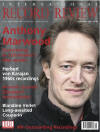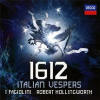Texte paru dans: / Appeared in:
*

International Record Review - (09/2012)
Pour
s'abonner / Subscription information
Decca
4783506

0028947835066 (ID235)
Consultez toutes les évaluations recensées pour ce cd
~~~~ Reach all the evaluations located for this CD
Back in the 1980s and early 1990s, liturgical reconstructions were ail the rage on radio and record. As a listener, I loved them because they gave context, space and purpose to the music. Rather than listening to each section of a Mass one after the other, overwhelmed by the unrelieved, wall-to-wall polyphony, how much more satisfying it was to listen to John Taverner’s Missa Gloria tibi Trinitas as sung by the Taverner Choir in the context of High Mass for Trinity Sunday during the composer’s lifetime at Cardinal College, Oxford (EMI 7 49103-2, recorded in 1986). Musicologist Hugh Keyte collaborated with Andrew Parrott on that recording, as he does with Robert Hollingworth on this one, though this time round Keyte brings a monumental reconstruction to the party — Giovanni Gabrieli’s 28-voice Magnificat. Talking of parties, it’s the 400th anniversary of Giovanni Gabrieli’s death this year, which is the main hook on which this ‘liturgical re-creation’ hangs. Plus, for added value, it’s also the 400th anniversary of the publication of a little-known volume of polychoral Vespers music by the Parmesan composer Lodovico Viadana.
We are invited to imagine ourselves
sitting in some glorious North Italian church in 1612 for the celebration of
Second Vespers of the Feast of Our Lady of the Most Holy Rosary (in
commemoration of the Battle of Lepanto, 1571). Unlike the Gabrieli Consort’s
‘A New Venetian Coronation’ liturgical reconstruction (which I nominated as
‘Outstanding’ in the last issue) there must be a resurgence of interest in
reconstructions — there’s less naked plainchant and fewer atmospheric sound
effects in this new recording. In fact, the recording and location of St
John’s,
resonant Douai Abbey, or the vast space of All Saints, Tooting which I
Fagiolini and Hollingworth chose for their feast of 40-part music by
Alessandro Striggio and Thomas Tallis (also ‘Outstanding’ in the May 2011
issue).
There’s no lack of sumptuousness when it comes to the choice of music. The five psalms and opening invocation by Viadana call for four choirs apiece, the choir count rising to seven for Keyte’s reconstruction of Gabrieli’s incomplete ceremonial Magnificat written for a Lepanto Day Vespers service at St Mark’s, Venice. A couple of double choir items and some sensuous five-part polyphony by Palestrina vary the texture pleasingly, with a few solo motets, an organ Toccata and brief snatches of plainchant offering some polychoral relief. It’s a heady mixture and the booklet essay by Keyte adds hugely to our historical understanding and musical enjoyment of the programme.
Viadana’s psalms, receiving their first recording here, are well worth the time and effort spent on their exhumation, their pithy directness nicely matched by the nimble speeds and springy rhythms set by Hollingworth. It took several runs through before I really began to appreciate the full colours and textural shadings produced by the four choirs here: a five-part choir of virtuoso soloists, a four-part ‘full’ chorus and the two instrumental choirs (high and low), which, in this performance, follow Viadana’s unusual suggestion for the imaginative mixing of reeds, strings and brass within, rather than between, each choir. The Office Hymn, Ave Maris Stella, is a fascinating hybrid with its opening and closing verses taken from Monteverdi’s Vespers of 1610 and the intervening verses by the Roman composer Soriano.
To conclude the service there’s an unfamiliar version of Giovanni Gabrieli’s well-known motet In ecclesiis, which Keyte hypothesizes originally had parts for two additional choirs. Instead of the work sounding as though it’s gained a few too many extra pounds in the ‘massive sonority’ department, I Fagiolini keeps things fairly light and crisp. More impressive still is Keyte’s reconstruction of Giovanni Gabrieli’s monumental 28-part Magnificat, which has tremendous breadth and sweep and resonates to some huge climaxes. Yet, again, these are not simply vast, faceless block chords; the singers and instrumentalists breathe life into these textures, so that you are constantly aware of different vocal spacings and tantalizingly beautiful groupings of voices and instruments. There’s one big surprise in store — so look away now if you’d like to experience it afresh — before the (textually significant) tenth verse the music suddenly comes to a halt and Keyte takes this General Pause to indicate an opportunity for an improvised military fanfare in honour of the victory over the Ottoman navy at Lepanto. Something suitably splendid has been concocted with bells, fanfares and fireworks, which overlaps jingoistically with the final exultant verses of the piece.
Terrific to have so much fine new music by Viadana and Giovanni Gabrieli, but on balance this new offering doesn’t match the atmospheric recording and gusto of Paul McCreesh’s ‘A New Venetian Coronation’. Nor does it have quite the panache of I Fagiolini’s Striggio and Tallis album from last year, though it works wonderfully well as a sequel: the two discs together showing how the polychoral style of the late Renaissance develops harmonic foundations and segues seamlessly into the more dramatically charged world of the early Baroque. First-rate scholarship from Keyte, a welcome return of the ‘liturgical recreation’ and a wonderfully uplifting and educational experience all round.
Cliquez l'un ou l'autre
bouton pour découvrir bien d'autres critiques de CD
Click either button for many other reviews


